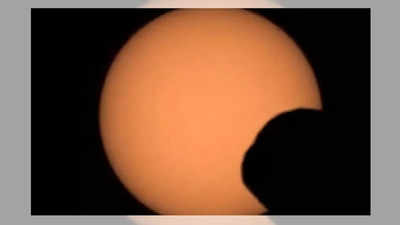
Mars, the fourth planet from the Sun, has long fascinated scientists and space enthusiasts alike due to its potential to harbour life and its geological history. The Perseverance Rover, a key player in NASA‘s Mars exploration efforts, has been investigating the Martian surface since its landing in February 2021. Equipped with advanced scientific instruments, Perseverance aims to uncover the secrets of Mars, including the possibility of past life.
The recent observations made by the Perseverance Rover, including the captivating solar eclipse caused by Phobos, contribute significantly to our knowledge of Mars and its moons.
These findings enhance our understanding of the Martian environment and its geological history while fueling the search for signs of past life. As NASA continues to explore Mars, each discovery provides invaluable insights into the planet’s past, its current conditions, and the possibilities for future exploration. The study of Phobos and the ongoing research by Perseverance highlight the importance of robotic exploration in unravelling the mysteries of our solar system and beyond.
Perseverance captures a “googly eye” eclipse: Exploring Phobos’ transit and its scientific implications for Mars
Perseverance Rover recorded an extraordinary video of a partial solar eclipse as Phobos moved between the Sun and Mars. This rare event resulted in a striking visual effect that NASA described as a “googly eye.” In the footage, Phobos appears as the pupil, and the Sun acts as the iris, creating a whimsical analogy. This moment occurred on the Rover’s 1,285th day on Mars, showcasing Perseverance’s ability to document significant astronomical occurrences.
The significance of this capture extends beyond mere aesthetics; it highlights the Rover’s scientific capabilities and its role in monitoring and understanding the dynamic relationship between Mars and its moons. The ability to observe such events provides valuable data about Phobos’ orbit and its interactions with solar radiation, contributing to a deeper understanding of both the moon and Mars itself.
Previous observations of Phobos
Perseverance’s observation of Phobos is not an isolated incident. Other Mars missions have also documented transits of this moon. The Curiosity Rover captured a video of Phobos in 2019, while the Opportunity Rover took an image back in 2004. These earlier observations have paved the way for a more comprehensive understanding of Phobos’ behaviour and its significance in the Martian environment.
Understanding Phobos
Phobos is one of two moons orbiting Mars, the other being Deimos. Discovered in 1877 by astronomer Asaph Hall, Phobos is named after the Greek god of fear, which is fitting given its connection to Mars, the god of war. The moon is irregularly shaped, measuring approximately 27 kilometres long, 22 kilometres wide, and 18 kilometres high. Its potato-like form contrasts sharply with the more spherical shapes of larger moons in the solar system.
Phobos orbits Mars at an astonishing speed, completing three full orbits in just one Martian day (about 11 hours). This rapid orbit places it so close to the planet’s surface that there are locations on Mars where Phobos may not be visible at all. The proximity of Phobos to Mars is not just a curiosity; it has serious implications for the moon’s future.
The future of Phobos and the Cheyava falls discovery: Insights into Mars’ potential for life and geological evolution
Phobos is gradually moving closer to Mars, advancing at a rate of about six feet (1.8 metres) every century. This slow but steady approach raises the possibility that, in approximately 50 million years, Phobos may either collide with Mars or break apart, forming a ring around the planet. This potential for future interaction between the moon and the planet offers scientists an intriguing avenue for research, as understanding these dynamics could reveal important information about the formation and evolution of planetary bodies in our solar system.
In addition to documenting Phobos’ transits, Perseverance has been conducting scientific investigations of the Martian surface. In July 2024, the Rover discovered a rock sample nicknamed “Cheyava Falls.” This sample is particularly noteworthy because it contains organic molecules and structures that could indicate the presence of microbial life. NASA posits that these chemical signatures and structures may have formed billions of years ago, during a period when Mars had running water, creating conditions that could support life.
The implications of this discovery are profound. If these organic molecules are indeed linked to past life, they could reshape our understanding of Mars as a once-habitable planet. The ongoing analysis of such samples will be crucial for assessing the planet’s geological history and its potential to support life.
